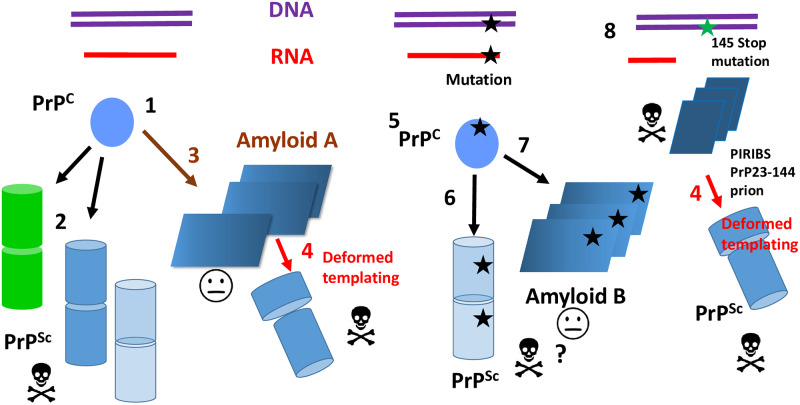Fig 2. The many conformations of PrP.
The Prpn/PRPN gene is transcribed and translated into the PrP polypeptide, which readily adopts the PrPC conformation (1). PrPC can refold to adopt one of several PrPSc strain conformations (2). These can be pathogenic (skull and bones sign) or not (face sign). PrPSc is depicted as stacked cylinders assuming that it is a 4Rβ [4], although its nature is not settled without doubt yet [25]. Different PrPSc strains exhibit different degrees of resistance to PK. PK-sensitive PrPSc exists (transparent cylinders). PrPC can be also refolded in vitro and adopt a PIRIBS amyloid conformation that can propagate in the brain upon inoculation and can be further transmitted by inoculation as an infectious agent (3). The darker shade indicates a PK-resistant C-terminus. During successive passages, deformed templating results in evolution of this conformer to PrPSc (4). Different mutations in PRNP result in PrPC (5) with a higher tendency to refold into a variety of propagative PrP conformers that form insoluble aggregates. In tg 117V mice, they include PK-sensitive, pathogenic PrPSc (6) and a transmissible, nonpathogenic PrP amyloid (7) with a characteristic pattern of resistance to PK (an approximately 8-kDa band corresponding to a segment that is different to that seen in the propagative amyloid described above and is signaled by the darker shading). It should be noted, however, that a recent study suggests that the approximately 8-kDa fragments are infectious and pathogenic and that they might exhibit a 2-rung solenoidal architecture [17]. A 145Stop mutation in PRNP results in PrP23-144 that folds into a propagative and pathogenic PIRIBS amyloid (8). During passage to wild-type mice, deformed templating occurs, resulting in emergence of PrPSc. PK, proteinase K; PIRIBS, parallel in register beta strand; PrP, prion protein; PrPC, prion protein with cellular conformation; PrPSc prion protein with scrapie conformation.

